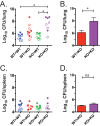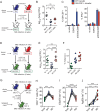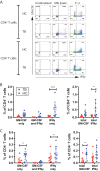Role of Granulocyte-Macrophage Colony-Stimulating Factor Production by T Cells during Mycobacterium tuberculosis Infection
- PMID: 29066547
- PMCID: PMC5654932
- DOI: 10.1128/mBio.01514-17
Role of Granulocyte-Macrophage Colony-Stimulating Factor Production by T Cells during Mycobacterium tuberculosis Infection
Abstract
Mice deficient for granulocyte-macrophage colony-stimulating factor (GM-CSF-/-) are highly susceptible to infection with Mycobacterium tuberculosis, and clinical data have shown that anti-GM-CSF neutralizing antibodies can lead to increased susceptibility to tuberculosis in otherwise healthy people. GM-CSF activates human and murine macrophages to inhibit intracellular M. tuberculosis growth. We have previously shown that GM-CSF produced by iNKT cells inhibits growth of M. tuberculosis However, the more general role of T cell-derived GM-CSF during infection has not been defined and how GM-CSF activates macrophages to inhibit bacterial growth is unknown. Here we demonstrate that, in addition to nonconventional T cells, conventional T cells also produce GM-CSF during M. tuberculosis infection. Early during infection, nonconventional iNKT cells and γδ T cells are the main source of GM-CSF, a role subsequently assumed by conventional CD4+ T cells as the infection progresses. M. tuberculosis-specific T cells producing GM-CSF are also detected in the peripheral blood of infected people. Under conditions where nonhematopoietic production of GM-CSF is deficient, T cell production of GM-CSF is protective and required for control of M. tuberculosis infection. However, GM-CSF is not required for T cell-mediated protection in settings where GM-CSF is produced by other cell types. Finally, using an in vitro macrophage infection model, we demonstrate that GM-CSF inhibition of M. tuberculosis growth requires the expression of peroxisome proliferator-activated receptor gamma (PPARγ). Thus, we identified GM-CSF production as a novel T cell effector function. These findings suggest that a strategy augmenting T cell production of GM-CSF could enhance host resistance against M. tuberculosisIMPORTANCEMycobacterium tuberculosis is the bacterium that causes tuberculosis, the leading cause of death by any infection worldwide. T cells are critical components of the immune response to Mycobacterium tuberculosis While gamma interferon (IFN-γ) is a key effector function of T cells during infection, a failed phase IIb clinical trial and other studies have revealed that IFN-γ production alone is not sufficient to control M. tuberculosis In this study, we demonstrate that CD4+, CD8+, and nonconventional T cells produce GM-CSF during Mycobacterium tuberculosis infection in mice and in the peripheral blood of infected humans. Under conditions where other sources of GM-CSF are absent, T cell production of GM-CSF is protective and is required for control of infection. GM-CSF activation of macrophages to limit bacterial growth requires host expression of the transcription factor PPARγ. The identification of GM-CSF production as a T cell effector function may inform future host-directed therapy or vaccine designs.
Keywords: GM-CSF; Mycobacterium tuberculosis; T cells; cytokines; lung infection; macrophages.
Copyright © 2017 Rothchild et al.
Figures







Comment in
-
T Cell Production of GM-CSF Protects the Host during Experimental Tuberculosis.mBio. 2017 Dec 12;8(6):e02087-17. doi: 10.1128/mBio.02087-17. mBio. 2017. PMID: 29233902 Free PMC article.
Similar articles
-
GM-CSF Dependent Differential Control of Mycobacterium tuberculosis Infection in Human and Mouse Macrophages: Is Macrophage Source of GM-CSF Critical to Tuberculosis Immunity?Front Immunol. 2020 Jul 23;11:1599. doi: 10.3389/fimmu.2020.01599. eCollection 2020. Front Immunol. 2020. PMID: 32793233 Free PMC article.
-
T Cell Production of GM-CSF Protects the Host during Experimental Tuberculosis.mBio. 2017 Dec 12;8(6):e02087-17. doi: 10.1128/mBio.02087-17. mBio. 2017. PMID: 29233902 Free PMC article.
-
IFN-γ-independent control of M. tuberculosis requires CD4 T cell-derived GM-CSF and activation of HIF-1α.PLoS Pathog. 2022 Jul 25;18(7):e1010721. doi: 10.1371/journal.ppat.1010721. eCollection 2022 Jul. PLoS Pathog. 2022. PMID: 35877763 Free PMC article.
-
Is interferon-gamma the right marker for bacille Calmette-Guérin-induced immune protection? The missing link in our understanding of tuberculosis immunology.Clin Exp Immunol. 2012 Sep;169(3):213-9. doi: 10.1111/j.1365-2249.2012.04614.x. Clin Exp Immunol. 2012. PMID: 22861360 Free PMC article. Review.
-
[Protective immunity against Mycobacterium tuberculosis].Kekkaku. 2006 Nov;81(11):687-91. Kekkaku. 2006. PMID: 17154048 Review. Japanese.
Cited by
-
Interactions between CNS and immune cells in tuberculous meningitis.Front Immunol. 2024 Feb 1;15:1326859. doi: 10.3389/fimmu.2024.1326859. eCollection 2024. Front Immunol. 2024. PMID: 38361935 Free PMC article. Review.
-
A Xenopus tadpole alternative model to study innate-like T cell-mediated anti-mycobacterial immunity.Dev Comp Immunol. 2019 Mar;92:253-259. doi: 10.1016/j.dci.2018.12.002. Epub 2018 Dec 4. Dev Comp Immunol. 2019. PMID: 30521838 Free PMC article. Review.
-
Recent Advances in Host-Directed Therapies for Tuberculosis and Malaria.Front Cell Infect Microbiol. 2022 May 20;12:905278. doi: 10.3389/fcimb.2022.905278. eCollection 2022. Front Cell Infect Microbiol. 2022. PMID: 35669122 Free PMC article. Review.
-
Enhanced Mycobacterial Antigen-Induced Pro-Inflammatory Cytokine Production in Lymph Node Tuberculosis.Am J Trop Med Hyg. 2019 Jun;100(6):1401-1406. doi: 10.4269/ajtmh.18-0834. Am J Trop Med Hyg. 2019. PMID: 30994092 Free PMC article.
-
BCG as a Case Study for Precision Vaccine Development: Lessons From Vaccine Heterogeneity, Trained Immunity, and Immune Ontogeny.Front Microbiol. 2020 Mar 11;11:332. doi: 10.3389/fmicb.2020.00332. eCollection 2020. Front Microbiol. 2020. PMID: 32218774 Free PMC article. Review.
References
-
- Orme IM. 1987. The kinetics of emergence and loss of mediator T lymphocytes acquired in response to infection with Mycobacterium tuberculosis. J Immunol 138:293–298. - PubMed
-
- Orme IM. 1988. Characteristics and specificity of acquired immunologic memory to Mycobacterium tuberculosis infection. J Immunol 140:3589–3593. - PubMed
Publication types
MeSH terms
Substances
Grants and funding
LinkOut - more resources
Full Text Sources
Other Literature Sources
Medical
Research Materials

